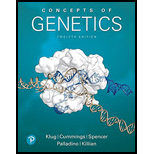
EBK CONCEPTS OF GENETICS
12th Edition
ISBN: 9780134818979
Author: Killian
Publisher: YUZU
expand_more
expand_more
format_list_bulleted
Textbook Question
Chapter 11, Problem 24PDQ
In 1994, telomerase activity was discovered in human cancer cell lines. Although telomerase is not active in human somatic tissue, human somatic cells do contain the genes for telomerase proteins and telomerase RNA. Since inappropriate activation of telomerase may contribute to cancer, why do you think the genes coding for this enzyme have been maintained in the human genome throughout evolution? Are there any types of human body cells where telomerase activation would be advantageous or even necessary? Explain.
Expert Solution & Answer
Want to see the full answer?
Check out a sample textbook solution
Students have asked these similar questions
Briefly state the physical meaning of the electrocapillary equation (Lippman equation).
Explain in a small summary how:
What genetic information can be obtained from a Punnet square? What genetic information cannot be determined from a Punnet square?
Why might a Punnet Square be beneficial to understanding genetics/inheritance?
In a small summary write down:
Chapter 11 Solutions
EBK CONCEPTS OF GENETICS
Ch. 11 - In the Meselson-Stahl experiment, which of the...Ch. 11 - An alien organism was investigated. When DNA...Ch. 11 - Why might mutations in genes encoding telomerase...Ch. 11 - Although the brother is an immunologically matched...Ch. 11 - Prob. 3CSCh. 11 - HOW DOWE KNOW? In this chapter, we focused on how...Ch. 11 - CONCEPT QUESTION Review the Chapter Concepts list...Ch. 11 - Compare conservative, semiconservative, and...Ch. 11 - Describe the role of 15N in the MeselsonStahl...Ch. 11 - Predict the results of the experiment by Taylor,...
Ch. 11 - What are the requirements for in vitro synthesis...Ch. 11 - In Kornbergs initial experiments, it was rumored...Ch. 11 - How did Kornberg assess the fidelity of DNA...Ch. 11 - Which characteristics of DNA polymerase I raised...Ch. 11 - Kornberg showed that nucleotides are added to the...Ch. 11 - What was the significance of the polA1 mutation?Ch. 11 - Summarize and compare the properties of DNA...Ch. 11 - List and describe the function of the ten subunits...Ch. 11 - Distinguish between (a) unidirectional and...Ch. 11 - List the proteins that unwind DNA during in vivo...Ch. 11 - Define and indicate the significance of (a)...Ch. 11 - Outline the current model for DNA synthesis.Ch. 11 - Why is DNA synthesis expected to be more complex...Ch. 11 - Suppose that E. coli synthesizes DNA at a rate of...Ch. 11 - Several temperature-sensitive mutant strains of E....Ch. 11 - While many commonly used antibiotics interfere...Ch. 11 - Describe the end-replication problem in...Ch. 11 - Many of the gene products involved in DNA...Ch. 11 - In 1994, telomerase activity was discovered in...Ch. 11 - The genome of D. melanogaster consists of...Ch. 11 - Prob. 26ESPCh. 11 - DNA polymerases in all organisms add only 5...Ch. 11 - Assume that the sequence of bases shown below is...Ch. 11 - Reiji and Tuneko Okazaki conducted a now classic...Ch. 11 - Consider the drawing of a dinucleotide below. (a)...Ch. 11 - To gauge the fidelity of DNA synthesis, Arthur...
Knowledge Booster
Learn more about
Need a deep-dive on the concept behind this application? Look no further. Learn more about this topic, biology and related others by exploring similar questions and additional content below.Similar questions
- Not part of a graded assignment, from a past midtermarrow_forwardNoggin mutation: The mouse, one of the phenotypic consequences of Noggin mutationis mispatterning of the spinal cord, in the posterior region of the mouse embryo, suchthat in the hindlimb region the more ventral fates are lost, and the dorsal Pax3 domain isexpanded. (this experiment is not in the lectures).a. Hypothesis for why: What would be your hypothesis for why the ventral fatesare lost and dorsal fates expanded? Include in your answer the words notochord,BMP, SHH and either (or both of) surface ectoderm or lateral plate mesodermarrow_forwardNot part of a graded assignment, from a past midtermarrow_forward
- Explain in a flowcharts organazing the words down below: genetics Chromosomes Inheritance DNA & Genes Mutations Proteinsarrow_forwardplease helparrow_forwardWhat does the heavy dark line along collecting duct tell us about water reabsorption in this individual at this time? What does the heavy dark line along collecting duct tell us about ADH secretion in this individual at this time?arrow_forward
arrow_back_ios
SEE MORE QUESTIONS
arrow_forward_ios
Recommended textbooks for you
 Human Heredity: Principles and Issues (MindTap Co...BiologyISBN:9781305251052Author:Michael CummingsPublisher:Cengage Learning
Human Heredity: Principles and Issues (MindTap Co...BiologyISBN:9781305251052Author:Michael CummingsPublisher:Cengage Learning Biology Today and Tomorrow without Physiology (Mi...BiologyISBN:9781305117396Author:Cecie Starr, Christine Evers, Lisa StarrPublisher:Cengage Learning
Biology Today and Tomorrow without Physiology (Mi...BiologyISBN:9781305117396Author:Cecie Starr, Christine Evers, Lisa StarrPublisher:Cengage Learning Biology (MindTap Course List)BiologyISBN:9781337392938Author:Eldra Solomon, Charles Martin, Diana W. Martin, Linda R. BergPublisher:Cengage Learning
Biology (MindTap Course List)BiologyISBN:9781337392938Author:Eldra Solomon, Charles Martin, Diana W. Martin, Linda R. BergPublisher:Cengage Learning Biology 2eBiologyISBN:9781947172517Author:Matthew Douglas, Jung Choi, Mary Ann ClarkPublisher:OpenStax
Biology 2eBiologyISBN:9781947172517Author:Matthew Douglas, Jung Choi, Mary Ann ClarkPublisher:OpenStax Biology: The Dynamic Science (MindTap Course List)BiologyISBN:9781305389892Author:Peter J. Russell, Paul E. Hertz, Beverly McMillanPublisher:Cengage Learning
Biology: The Dynamic Science (MindTap Course List)BiologyISBN:9781305389892Author:Peter J. Russell, Paul E. Hertz, Beverly McMillanPublisher:Cengage Learning BiochemistryBiochemistryISBN:9781305577206Author:Reginald H. Garrett, Charles M. GrishamPublisher:Cengage Learning
BiochemistryBiochemistryISBN:9781305577206Author:Reginald H. Garrett, Charles M. GrishamPublisher:Cengage Learning

Human Heredity: Principles and Issues (MindTap Co...
Biology
ISBN:9781305251052
Author:Michael Cummings
Publisher:Cengage Learning

Biology Today and Tomorrow without Physiology (Mi...
Biology
ISBN:9781305117396
Author:Cecie Starr, Christine Evers, Lisa Starr
Publisher:Cengage Learning

Biology (MindTap Course List)
Biology
ISBN:9781337392938
Author:Eldra Solomon, Charles Martin, Diana W. Martin, Linda R. Berg
Publisher:Cengage Learning

Biology 2e
Biology
ISBN:9781947172517
Author:Matthew Douglas, Jung Choi, Mary Ann Clark
Publisher:OpenStax

Biology: The Dynamic Science (MindTap Course List)
Biology
ISBN:9781305389892
Author:Peter J. Russell, Paul E. Hertz, Beverly McMillan
Publisher:Cengage Learning

Biochemistry
Biochemistry
ISBN:9781305577206
Author:Reginald H. Garrett, Charles M. Grisham
Publisher:Cengage Learning
What are Mutations and what are the different types of Mutations?; Author: Science ABC;https://www.youtube.com/watch?v=I16YlE8qTBU;License: Standard youtube license